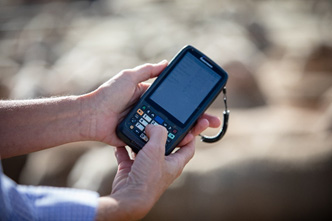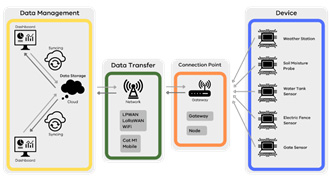Digital agriculture, AgTech and the Internet of Things

Digital Agriculture, AgTech and the Internet of Things (IoT) are fast becoming more common in the agriculture sector, but what are they? Using examples relevant to farm businesses, this article explains what each term means.
Digital Agriculture
Digital Agriculture is often used to describe different the use of data collected by different types of technology used in the sector. However, it is also about how this technology integrates and works across the supply chain, all the way from the paddock to the consumer.
Digital Agriculture can help with the day-to-day management of farms and improve traceability, security and automation. It includes monitoring animals, prescriptive fertiliser programs and geospatial mapping.
If you are thinking about incorporating Digital Agriculture into your business, you should consider:
- Return on investment.
- Integrating data into decision making.
AgTech
 AgTech is any innovation in the agriculture sector (farm to consumer) designed to improve efficiency, profitability and or sustainability. It includes devices, sensors, virtual reality, robotics, automation and artificial intelligence.
AgTech is any innovation in the agriculture sector (farm to consumer) designed to improve efficiency, profitability and or sustainability. It includes devices, sensors, virtual reality, robotics, automation and artificial intelligence.
AgTech can work by itself or be part of a network of devices such as the Internet of Things (IoT), where devices can connect to and interact with each other and the internet (see below).
On farms, AgTech can:
- Make decision-making easier and quicker.
- Provide more reliable and accessible information.
- Provide evidence of sustainability, improved efficiency, and increased profitability.
Examples of AgTech used on farms includes:
- Water sensors for tanks, troughs and irrigation.
- Weather stations and soil moisture monitoring.
- Gate and fence sensors.
- Electronic identification tags.
- Autonomous vehicles.
If you are investigating how AgTech could benefit you and your business, you should also read: AgTech what you need to know.
Internet of Things
 The Internet of Things, or IoT, refers to devices or ‘things’ embedded with sensors so they can measure and transmit data via a network. When it comes to IoT in agriculture, a ‘thing’ could be a tractor, shed, weather station or sheep. It could even be a person.
The Internet of Things, or IoT, refers to devices or ‘things’ embedded with sensors so they can measure and transmit data via a network. When it comes to IoT in agriculture, a ‘thing’ could be a tractor, shed, weather station or sheep. It could even be a person.
IoT devices connect and interact with each other and the internet, which means they can work together to send alerts or automate other ‘things’ such as sprinkler in an orchard.
Figure 2: The image explains the collection and transfer of information from devices or sensors (right hand side) through a gateway via a network to data management applications where the information is viewed and stored.
The data IoT devices generate is often sent to what is known as an interface or dashboard. This is where farmers access the information they need, often in real-time, to make more informed decisions. For example, the wind speed in a particular paddock or how much water is in a trough can be found out just by opening an app on a phone, saving time and providing peace of mind.
Before purchasing IoT devices for your farm business, you should consider:
- The type of connectivity needed for devices to ‘talk’ to each other and connect to the internet. The topography and location of your farm might determine what options are available to you.
- How you want to access your data and what decisions it will allow you to make.
- After sales service, subscription costs and who and how long it will take to install your devices.